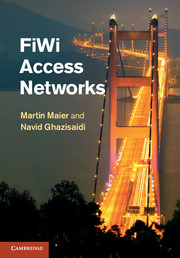8 - LTE
from Part III - Wireless access networks
Published online by Cambridge University Press: 05 January 2012
Summary
Long term evolution (LTE) has been defined by the third generation partnership project (3GPP) as fourth-generation (4G) cellular network technology for high-speed wireless end-users. In this chapter, we provide an overview of the salient features and most important specifications of LTE and next-generation LTE-Advanced networks.
PHY layer
The first amendment of LTE (release 8) provides a transmission rate of 300 Mb/s and operates in both time division duplex (TDD) and frequency division duplex (FDD) modes. 4G LTE provides simplicity for both operators and end-users (Pospishny et al. [2010]). LTE operators are given the flexibility to define the size of bandwidth, ranging from below 5 MHz up to 20 MHz. Furthermore, various user-friendly features have been considered in 4G LTE networks, including plug-and-play and self-configuration.
LTE aims at providing a smooth evolution from earlier 3GPP and 3GPP2 cellular networks such as wide-band code division multiple access/high-speed packet access (WCDMA/HSPA) and code division multiple access (CDMA2000) (Astely et al. [2009]). Typically, orthogonal frequency division multiplexing (OFDM) is used in the downlink radio transmission of LTE networks. Using narrow-band subcarriers in combination with a cyclic prefix leads to a radio transmission that is robust against time dispersion. As a result, the cost and power consumption of mobile end-users decrease due to the simplified receiver baseband processing. Moreover, LTE supports advanced multi-antenna schemes such as single/multiple-user multiple input multiple output (MIMO) antennas, transmit diversity, spatial multiplexing, and beamforming.
- Type
- Chapter
- Information
- FiWi Access Networks , pp. 98 - 104Publisher: Cambridge University PressPrint publication year: 2011



